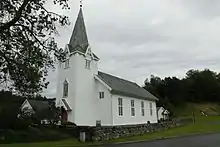| Sand Church | |
|---|---|
| Sand kyrkje | |
 View of the church | |
| 59°28′58″N 6°15′09″E / 59.48272°N 06.252495°E | |
| Location | Suldal Municipality, Rogaland |
| Country | Norway |
| Denomination | Church of Norway |
| Churchmanship | Evangelical Lutheran |
| History | |
| Status | Parish church |
| Founded | 12th century |
| Consecrated | 1852 |
| Architecture | |
| Functional status | Active |
| Architect(s) | Hans Linstow |
| Architectural type | Long church |
| Completed | 1852 |
| Specifications | |
| Capacity | 450 |
| Materials | Wood |
| Administration | |
| Diocese | Stavanger bispedømme |
| Deanery | Ryfylke prosti |
| Parish | Sand |
| Type | Church |
| Status | Not protected |
| ID | 85370 |
Sand Church (Norwegian: Sand kyrkje) is a parish church of the Church of Norway in Suldal Municipality in Rogaland county, Norway. It is located in the village of Sand. It is the church for the Sand parish which is part of the Ryfylke prosti (deanery) in the Diocese of Stavanger. The white, wooden church was built in a long church design in 1852 using designs by the architect Hans Linstow. The church seats about 450 people.[1][2]
History

The earliest existing historical records of the church date back to the year 1283, but it was not new that year. The first church in Sand was a stave church that was built on a high hill about 60 metres (200 ft) east of the present site of the church.
Around the year 1600, the old stave church was torn down and replaced with a timber-framed building on the same site. In 1852, a new church was built at the bottom of the hill, about 60 metres (200 ft) west of the old site of the church. After the new church was completed, the old church was torn down. The old church grounds were converted into a cemetery.[3][4]
See also
References
- ↑ "Sand kyrkje, Suldal". Kirkesøk: Kirkebyggdatabasen. Retrieved 17 October 2020.
- ↑ "Oversikt over Nåværende Kirker" (in Norwegian). KirkeKonsulenten.no. Retrieved 17 October 2020.
- ↑ "Sand gamle kirkested - Kyrkjehauen" (in Norwegian). Norwegian Directorate for Cultural Heritage. Retrieved 17 October 2020.
- ↑ "Sand kyrkjestad / Sand kyrkje 2" (in Norwegian). Norwegian Directorate for Cultural Heritage. Retrieved 17 October 2020.